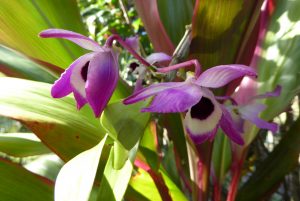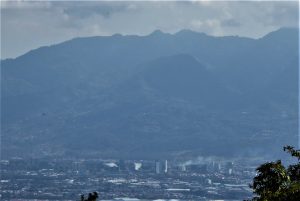In this series of posts, Carsten Brühl reports about his current trip to Costa Rica. Part 1 is all about his first impressions and what he learned about pesticide use on tropical crops such as the bananas that get shipped to Germany.
Costa Rica is well-known for its rainforests, volcanoes, and beaches and the tropical biodiversity these habitats harbour. But not everyone might know that Costa Rica is also producing a major part of the bananas and pineapples that are consumed globally. Just check the shelves in your local grocery store! A lot of pesticides are used to grow these crops year-round in a humid environment, which poses a lot of questions about their environmental effects. I was happy when I was offered the opportunity to visit colleagues of the National University of Costa Rica in Heredia to get an impression of the situation and to meet students in their master course where I was invited to lecture on exposure and effects of pesticides and their evaluation in risk assessment.
Arriving from a cold German winter in the Valle central of Costa Rica, I was embraced by balmy air and the sounds of the bustling capital of San Jose. My host Clemens Ruepert took me to his house at the slopes of volcan Barva in his old VW bus, so I could adapt to the climate and experience a lush tropical vegetation and observe the visiting birds in the garden. While discussing pesticides and strolling through the neighbourhood and surrounding coffee plantations with the dogs, I got some more input for the preparation of the coming lecture.
The following day we had a meeting with the people responsible for the environmental risk assessment of pesticides at the Ministry of Environment. We were joined by Freylan Mena Torres, an ecotoxicologist also working at the Instituto Regional de Estudios en Sustancias Tóxicas de la Universidad Nacional (IRET-UNA). The meeting expanded from planned two hours to a full day as discussions unfolded on the application of European risk assessment schemes to tropical situations.
I learned that in Costa Rica more than 2,000 pesticide products are registered, among them for example more than 300 herbicides for weed control in banana alone. Banana in Costa Rica is also at the top of pesticide intensive crops in the world, with more than 60 kg active molecule applied over the year. This is more than 20 times the average amount that is applied in German crops and an order of magnitude will surely result in elevated effects. Applications are done by plane every three to four days. This intense use calls for some attention in an area where the surrounding biodiversity is amongst the richest in the world, especially since we do not know which species live in these tropical crops where exposure patterns are also very different from a temperate scenario.


